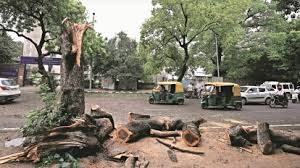Top court: Sustainable development doesn’t mean clearing forests using bulldozers

New Delhi, July 24 — India’s Supreme Court has strongly stated that sustainable development cannot be an excuse to destroy forests. The top court emphasized that clearing green zones with bulldozers goes against the very meaning of sustainability. This clear message came during a hearing on a large-scale infrastructure project involving deforestation.
Justices B.R. Gavai and K.V. Viswanathan noted that environmental care must be part of any development plan. They warned that using sustainability as a cover for destruction is both misleading and dangerous.
“You cannot bulldoze forests and call it sustainable. Development must work with nature, not against it,” the court said.
The Message Comes at a Crucial Time
India is facing many environmental problems. Heatwaves, floods, forest loss, and water shortages are becoming more frequent. At the same time, infrastructure projects are expanding rapidly.
Many recent projects—especially roads, mining, and industrial zones—have damaged eco-sensitive regions. Environmental experts say these projects often move forward without proper checks.
The court’s observation came during a case involving forest clearance in a biodiversity hotspot. Petitioners argued that bulldozers had already damaged large forest areas before any proper clearance was granted.
This prompted the court to speak out. According to the bench, real development includes protection, not destruction.
“Sustainability means balancing growth and nature. If one side falls, the balance breaks,” the court explained.
What Does Sustainable Development Really Mean?
The idea of sustainable development became popular after the 1987 Brundtland Report. It defined the term as development that meets current needs without harming the future.
However, the court pointed out a rising problem: many projects misuse this concept. Authorities and developers often use the term to gain easy approvals.
Instead of protecting the environment, they treat it as an obstacle. But the court made it clear—this is not acceptable.
True sustainable development ensures forests stand, rivers flow, and communities thrive. It doesn’t mean cutting corners or ignoring ecological harm.
Environmental Clearances Under the Scanner
The petitioners also raised concerns about how environmental clearances are granted. According to them, most clearances skip vital steps. These include public hearings, forest surveys, and wildlife impact reports.
The court has now asked the Ministry of Environment, Forest and Climate Change (MoEFCC) for a detailed record. It wants a list of projects cleared in the last five years—especially those involving forests.
Moreover, the judges called for stronger rules. They advised officials to stop approving projects that rely on bulldozing as the first step.
A report by the Centre for Science and Environment showed that nearly 90% of projects get cleared. This shows how easily norms are being bent.
Legal and Ecological Impact
This isn’t the first time the Supreme Court has stepped in. Over the years, it has blocked mining in fragile areas, stopped illegal construction near forests, and protected national parks.
But this time, the court focused on the misuse of the word “sustainability.” Developers and even some officials now use it to push through damaging projects.
Advocate Ritwick Dutta welcomed the ruling. “This verdict sends a strong signal. Growth must not come at the cost of nature,” he said.
He added that India’s development model often ignores long-term environmental harm. This approach may create jobs today but destroy resources tomorrow.
People and Wildlife Also Suffer
The court didn’t just speak for trees and land. It highlighted the human and animal cost as well. Forest communities, especially tribal groups, lose their homes and culture when land is cleared.
Wildlife faces the same danger. Bulldozers break natural corridors used by elephants, tigers, and other species. Many animals end up displaced or dead.
The court stated that preserving biodiversity is a legal and moral duty. Protecting forests is not just about green cover. It’s about saving lives and futures.
“You cannot rebuild a forest. Once gone, it’s lost for generations,” the bench observed.
Next Steps: Stronger Environmental Laws Needed
After the hearing, the court asked the MoEFCC to review its policies. It stressed the need for clearer rules and tougher checks before any trees are cut.
Environmentalists are now pushing Parliament to take stronger action. They want new laws that block false claims of green development.
The goal is to ensure every project undergoes honest reviews. Projects that ignore the environment should not be allowed to move forward.
Conclusion
The Supreme Court’s ruling is more than just a legal note—it is a wake-up call. India cannot chase growth by destroying the very nature it depends on.
Forests protect water sources, cool the air, and provide food and shelter to millions. Bulldozers may build roads, but they also break the land.
If development ignores nature, it is neither wise nor lasting. The future must include forests, not replace them with concrete.






